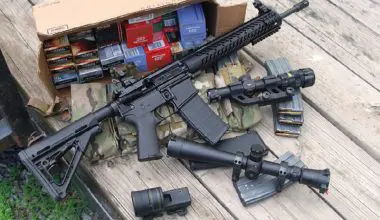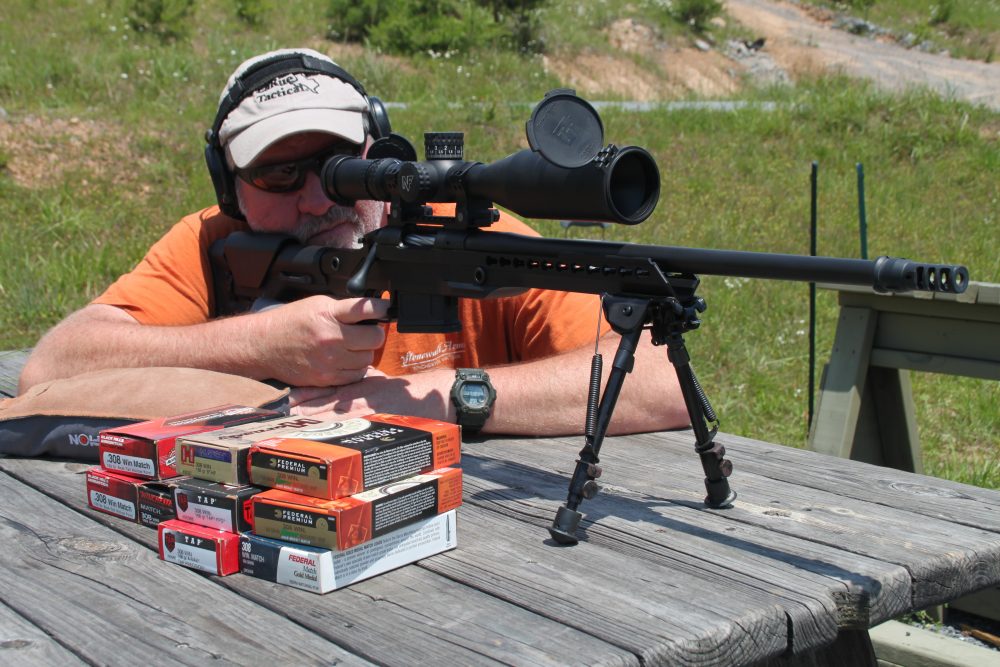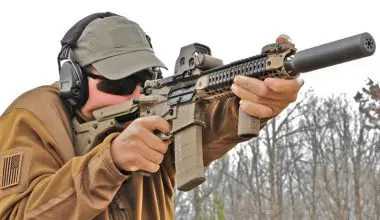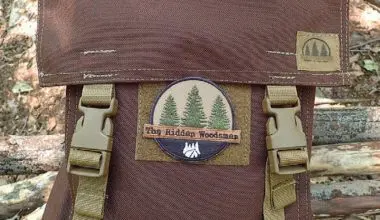
It was the mid-1940s and the planet was aflame. Two entire continents were awash in war on an industrial scale. In Europe, the Germans were exercising their creative bent for military innovation to a degree never seen before or since.
In few other areas of martial endeavor was this creativity better exemplified than in the world’s first assault rifle—the MP44. There were several essentially interchangeable designations. The original MP43 went on to become the MP44 and then the StG44 with minimal modifications, but the concept really began as a revolutionary new cartridge. Developed originally in 1938, the 7.92x33mm Kurz (short) cartridge was 24mm shorter than the German standard 7.92x57mm infantry round and carried exactly half the powder charge.
The abbreviated .30-caliber bullet traveled at 2,132 feet-per-second (fps) out of the gun’s 16.5-inch barrel. While this configuration delivered a trajectory that was grossly parabolic at long ranges, within the 300 meters that typically characterized infantry engagements, it was utterly lethal at a fraction of the size and weight of its big brother.
Table of Contents
STORM GUN
The German StG44 “Storm Gun” was the world’s first true assault rifle. It germinated from a tactical competition between a Haenel design called the Maschinenkarabiner MKb-42 (H) and a Walther offering titled the MKb-42 (W). Copies of each machine carbine variant were subjected to troop trials on the Eastern Front, and Hugo Schmeisser eventually modified the Haenel gun into the Maschinenpistole MP43. The radical new rifle was frequently referred to as “that Kraut Buck Rogers gun” by American GIs when they encountered it for the first time.
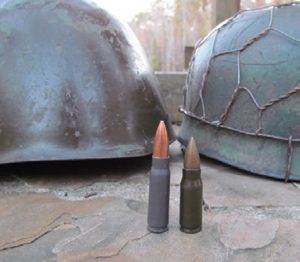
The MP44 fed from a 30-round detachable box magazine, was air-cooled, gas-operated, and offered controllable full-auto fire. Despite some earlier misgivings, Hitler was enthralled with the new gun and is said to have bestowed the Sturmgewehr or Storm Gun title upon it himself.
The gun weighed 11.5 pounds, but its stamped steel construction facilitated inexpensive mass production by semi-skilled workers. Its battlefield performance showed it to be a legitimate force multiplier. A single soldier or grenadier armed with an StG44 could produce firepower greater than a modest group of his peers sporting bolt-action rifles.
AND IN THE SOVIET UNION …
This fact was not lost on a young Russian tank crewman who was wounded defending his homeland from Nazi invaders. Mikhail Timofeyevich Kalashnikov was said to have developed the design for his eponymous rifle while recovering from wounds incurred during the Battle of Brausk against the Germans in 1941.
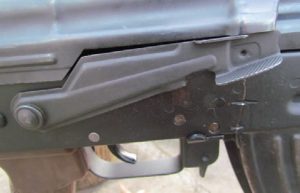
Soviet weapons designers have always been held in higher social esteem than their Western counterparts. While Comrade Kalashnikov enjoyed tremendous official accolades, he never benefitted financially to a great degree from his invention. Kalashnikov had little formal education and his tale has no doubt been embellished a bit by Communist propagandists.
But it’s indisputable that his efforts were critical to the development of the weapon that bears his name. After a fairly grueling design competition, Kalashnikov’s rifle was selected to arm the Soviet armed forces in the aftermath of the “Great Patriotic War.”
The original Kalashnikov rifles were built upon stamped receivers that
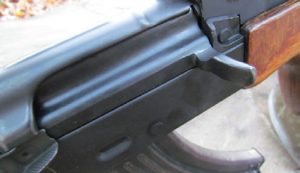
were eventually deemed too flimsy for serious military use. Subsequent Avtomat Kalashnikova (AK) rifles were built around a massive forged steel receiver and established a reputation for reliability unmatched to this day.
In the mid-1950s, the design was modernized and included a perfected stamped receiver and a new Modernizirovannyi Avtomat Kalashnikova (AKM) designation. The basic Kalashnikov action went on to drive the small-caliber AK-74 as well as the AKSU submachine gun, PK series belt-fed machineguns, RPK and RPK-74 Squad Automatic Weapons, and in modified form, the SVD sniper rifle. Current estimates have more than 100 million Kalashnikov rifles produced worldwide by
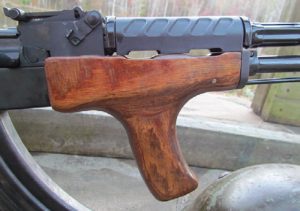
dozens of nations, and that number climbs daily.
The original 7.62x39mm M1943 round fired by the Kalashnikov pushed a 123-grain .30-caliber Spitzer bullet to 2,330 fps. Like the German 7.92x33mm Kurz round, this allowed for larger ammunition loads and controllable fully automatic fire while retaining enough horsepower to be effective at modest combat ranges.
DIFFERENCES
Most everything the Germans make is elegant, and the MP44 is no exception. Despite its pressed steel construction, the MP44 is robust and easily serviced in the field. The charging handle extends out the left side of the receiver and reciprocates with the bolt. The spring-loaded ejection port cover pops upward when the action is cycled, and the large magazine release button is adequate for use with gloves.
The wooden buttstock looks to be cut from a board and incorporates a storage space for a cleaning kit. The bizarre little gas block plug with the ball on the end is included to facilitate stacking arms in garrison.
The safety is a positive thumb lever. Up is safe and down is fire. The selector switch is a cross bolt. Push the button right for semi-auto fire, left “rock and roll.” The fire control group and buttstock are both retained via a single captive takedown pin. The fire control group pivots downward on a rivet and is not removable.
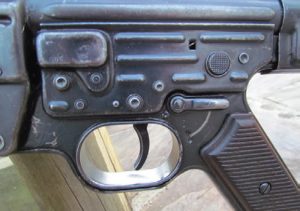
The forearm is a simple pressed steel component, and the barrel is threaded for a muzzle attachment. For reasons I have never understood, the sling mounts are on the right side of the rifle.
The AKM is a simpler, cruder weapon. The folded steel receiver is reinforced in several places with rivets and is robust enough in this configuration to last half a dozen lifetimes. The bolt is a massive two-lugged rotating affair that rides in a bolt carrier that is frequently chromed. The charging handle is a rigid appendage that protrudes out the right and reciprocates with the action.
The AK ranch gate safety-cum-selector lever has been much maligned. It is indeed noisy and is most easily manipulated with the thumb of the right hand. Activation requires removal of the right hand from the pistol grip. Up is safe, all the way down is semi-auto, and the middle position is full-auto.
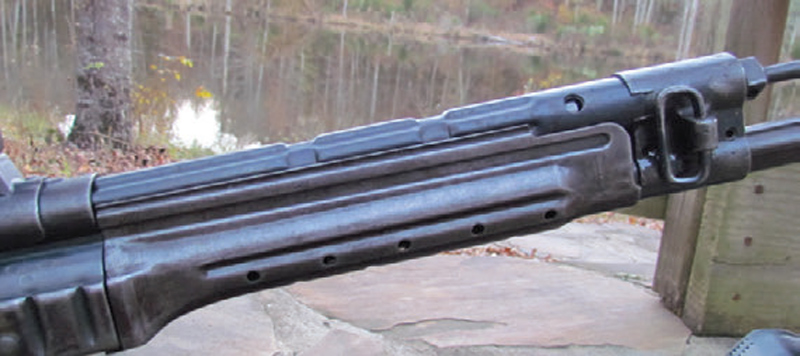
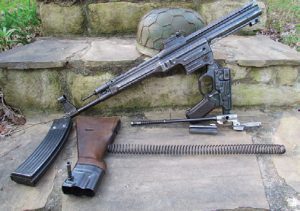
readily serviced in the field.
AK furniture comes in dozens of flavors, ranging from pedestrian industrial synthetics to beautiful natural woods. Romanian guns in particular frequently sported forearms equipped with a vertical foregrip that curved forward to accommodate tilting in the magazines.
Buttstocks include a trap door storage compartment. The forward sling attachment point is on the left side of the forearm. Rear attachment points are either on the heel of the buttstock or on the left side of forged-receiver AKs as well as most modern versions.
The sheet-metal receiver cover on the AK rattles on some models, and the rifle will fire just fine without it. The magazine release is a thumb lever with scant steel guard wings. Dimples pressed into the receiver keep the magazine firmly in place side-to-side.
SIMILARITIES
Both front sights are hooded, though the MP44 hood is removable. AK front sights can either be fully hooded with an access hole for a sight adjustment tool or incorporate heavy steel wings. Both rear sights are ramp adjustable and hopelessly optimistic. The MP44 sight adjusts to 800 meters, while the AK sight goes to an even kilometer. Both rifles are sometimes encountered with scope rails for optical sights.
Original magazines for both rifles are pressed steel, though there have been several varieties of synthetics used to make subsequent AK mags. MP44 magazines insert straight like an AR-15, while AK magazines must be hooked at the front and rocked rearward to lock in place. The MP44 mag well incorporates the slightest flare to make this process easier in a rush.
LET’S MAKE SOME NOISE
The AKM fires a heavier cartridge yet weighs nearly two pounds less and is a less comfortable rifle than the MP44 as a result. In all modes of fire, the AKM jumps around worse than the German weapon. Sight acquisition and use are comparable between both platforms, and the offset between the sight axis and bore is about the same.
The ergonomics of the MP44 beat the AK in all respects for right-handed operators. The thumb-activated safety and the left-sided charging handle allow the gun to run without shifting the right hand off the pistol grip. Magazine changes are quicker with the MP44 as mags do not have to be rocked in place. Neither rifle has a last round bolt hold open.
The AK carries better if the sling swivel is on the left side of the stock. If the rear swivel is on the heel of the stock, the AK rides awkwardly on a sling. The MP44 carries fine but it rides on the wrong side for right-handed shooters. The AK sling could conceivably be used to aid in tactical applications, but most military slings I have encountered are really too short for this purpose.
Trigger pulls are comparably long and creepy on both rifles. Neither platform lends itself to precise shooting, but a long, stiff trigger offers an added measure of safety on a utility-grade service weapon.
Follow-up shots and double taps are nicer with the MP44, as the mass of the gun and smaller cartridge conspire to keep the muzzle down and attenuate muzzle blast. On full-auto, the MP44 really finds its legs.
The rate of fire of the MP44 is just crazy slow. At around 500 rounds-per-minute, the rate compares favorably to the British Sten or American M3 Grease Gun, both of which are notoriously slow-firing subguns.
By contrast, the AKM runs at around 600 rpm. While this is not much faster, when combined with the lighter weapon and heavier cartridge, it equates to more muzzle rise. It takes very little talent to keep 30 rounds from the MP44 on a man-sized target at 50 meters when fired as a long single burst.
The MP44 has such a pathetic excuse for a handguard that the forearm gets uncomfortably hot in very short order. A glove for the left hand is a must if you are blessed with more than just a handful of rounds at a sitting. The AK foregrip is a little better but just barely. Both guns can quickly get uncomfortably hot.
Proper technique with a handheld automatic weapon involves leaning into the gun and allowing recoil to fight against your body weight and subsequently gravity. With proper technique, both rifles are controllable, but the MP44 much more so.
RELATIVE STATUS TODAY
Its 11.5-pound chassis weight notwithstanding, the MP44 would render proper service even today if well maintained and supplied with a decent diet of modern ammunition. With expanding bullets, the 7.92x33mm Kurz round would be adequate for whitetail deer and antelope as well as nuisance animals.
The original Storm Gun is an historical footnote today. Original specimens cost as much as a car and are found in only the most advanced collections. Additionally, ammunition is hard to find and expensive when available. By contrast, AKs are everywhere, and steel-cased 7.62x39mm runs a bit more than $5 per box at my local Walmart.
Regardless of the more than 70 years that have passed since the inception of the MP44, I would still embrace the rifle as a viable contemporary tactical tool. When fired alongside the subsequent AKM, the original German Storm Gun seems the better rifle in most respects.
Even in the Information Age, the world’s first true assault rifle could still be a tactical contender on most any modern battlefield. I can think of no higher praise for a design birthed in the desperate days of World War II and churned out of fairly primitive factories subjected to regular and relentless attack from the air.
